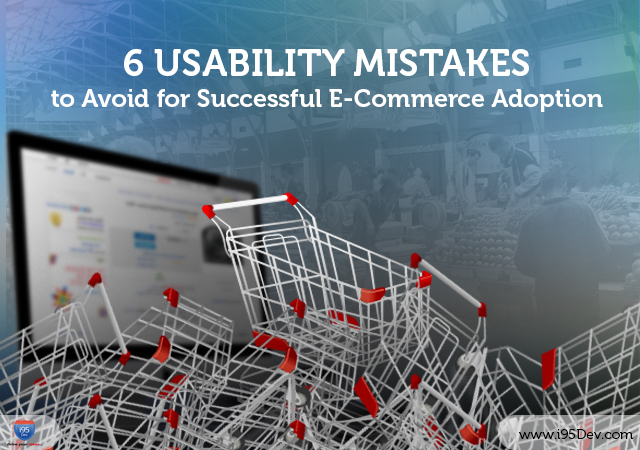In an earlier article, we had looked at the 6 Requirement Mistakes to Avoid for Successful E-commerce Adoption. In this article, we will go a one step further and look at a few usability mistakes that businesses must avoid to see success with their e-commerce initiatives.
1) Not considering mobile devices
According to internetretailer, mobile commerce in the U.S. is growing nearly 2.58 times faster than total e-commerce sales and accounts for nearly one-third of all U.S. e-commerce sales. Mobile as a medium can no longer be ignored and still a large number of e-commerce websites out there are not responsive. Today having a responsive e-commerce store can be the difference between success and failure for your e-commerce initiatives.
Not convinced? Consider these
- Globally, the number of users using a mobile device (1.7 billion) has crossed the number of desktop users in 2014. (comScore)
- Mobile web adoption is growing 8 times faster than web adoption did in the 1990s and early 2000s. (Nielsen)
- In the last 12 months, customers around the world ordered more than $1 billion worth of products from Amazon using a mobile device. (Compuware 2009)
- 63% of people expect to be doing more shopping on their mobile devices over the next couple of years. (Latitude)
Getting your mobile strategy right is very crucial. For more information on how you can take advantage of the growing popularity of mobile devices download our eBook – A Ready Reckoner to Mobile Commerce Fundamentals.
2) Not optimizing site navigation
Today customers are driven by desire for instant gratification and it is quite natural for them to expect the e-commerce store to load instantaneously, find the product in shortest possible time, entire checkout process to take minimal time, and order to be fulfilled in a day.
Having an e-commerce website that is difficult to navigate is a huge turnoff for visitors. Imagine having an amazing e-commerce site with plenty of visitors waiting to buy your product. Now, what good will that traffic be if the consumers are not able to find the right product (or have to invest a lot of time to find one) when they come to your e-commerce store.
An intuitive site navigation is necessary for businesses to reduce shopping cart abandonment and improve conversions. An effective site navigation involves multiple elements like its location on the page, type of navigation (left navigation, breadcrumb, etc.) number of elements in navigation, the words that you use, and more.
3) Ignoring the role of content
There is a reason why Content is often referred as King or the most important element it today’s digital era. Content not only helps in improving visibility and discoverability of your brand (its role in SEO) but also helps in converting (its role in personalization and lead nurturing) and retaining a customer (its role driving engagement). But, businesses often underestimate the value of content in multiple ways – not focusing on the quality of content, the type of content, the delivery of content, etc.
If you think this is true for other businesses and not for e-commerce businesses then you have been living under a rock. Content is at the heart of everything that is e-commerce – from rich product descriptions, product images, product videos, ratings and reviews to order confirmation emails, marketing newsletters and more. Before making a purchase decision consumers like to read product descriptions, look at product images and videos, see ratings and reviews, compare products based on that information, etc. Its role in e-commerce success cannot be emphasized enough.
For more information on the role of content in e-commerce personalization read our blog here.
4) Failing to build trust with your consumers
E-commerce business is all about trust and confidence; often customers are extending a leap of faith in a brand when they purchase online. By making purchases online they risk being scammed, purchasing a fake or damaged product, etc. Hence, it is important for businesses to take steps to establish and reinforce trust with customers as often as possible. Failing which, the businesses will struggle to gain traction and even if they do, they will sooner than later find themselves losing them to competition.
There are multiple ways businesses can build that trust with consumers – from installing firewalls, using https (using SSL certifications), getting PCI compliant to increasing transparency (eliminating hidden charges), showing customer ratings and reviews, and displaying trust symbols (like Verified by VISA, TrustPay, etc.).
Read how e-commerce and ERP integration help you build trust and how building trust can help reducing shopping cart abandonment.
5) Hiding information from consumers
Online shopping rides high on convenience and comfort it provides to the consumer; surfing from anywhere anytime to the delivery of items at their doorstep. On the flip side, distance also acts as a source of frustration, dissuasion, and hesitation for many buyers. While it varies from customer to customer, the hesitation, when it creeps in, is usually strong enough to keep consumers away from becoming your customer. Among other things, lack of transparency is one of the biggest contributor feeding that hesitation.
Hence it is important to ensure that you give your customers all the information they need to make an informed sales decision, including
- Display accurate and consistent product information and images (across channels if you are selling on multiple channels),
- Show the available product inventory,
- Display all product and delivery costs,
- Give customers multiple options to get in touch with you (including office address, contact email address, contact phone number, online chat, etc.),
- Always keep them informed about their order status,
- Encourage users to write reviews on your website, and more.
Engaging customers with a clear line of communication keeps them happy and wins their loyalty.
6) Lack of viable payments and shipping options
Imagine a situation where you have spent a lot of marketing dollars to attract consumers to your store. The consumer is on your store, products added to the cart and ready to checkout. But, during the checkout stage, the consumer realizes that the store does not support his preferred method of payment or shipment. The result, you end up losing the sale and the investment you had made to attract that customer.
Losing customers over a payment or shipping method is probably the least desirable ways of losing a customer. Understand your target segment preferences and provide your customers multiple shipping and payment options. The more options you provide to them the lesser are the chances of you losing sales. Moreover, multiple payment and shipping options also increase your reach enabling you to reach consumers who otherwise will never be your customers (cash on delivery being a very good example).
Conclusion
E-commerce is increasingly becoming commoditized with little differentiation between players. In such a scenario, you cannot be successful only because you are selling a product and even a small differentiation can be the difference between success and failure. The usability of your store plays a big role in converting visitors/ consumers to customers and in keeping customers coming back again and again.
Understand your customers and focus on providing them the best shopping experience. Are you planning to adopt e-commerce soon or have already been through the exercise? Let us know your thoughts by commenting below.


















